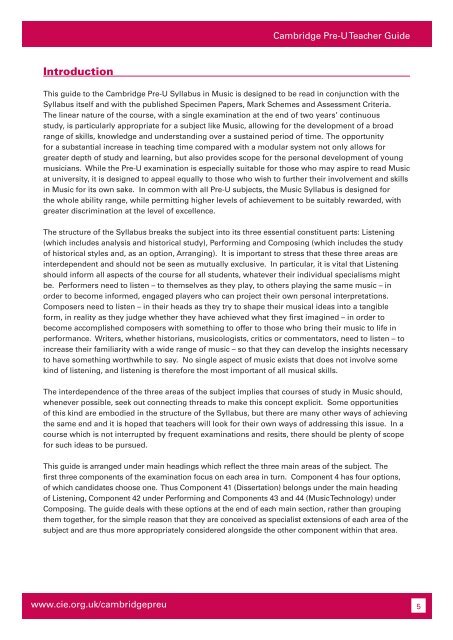Teacher's Guide Cambridge Pre-U MUSIC Available for teaching ...
Teacher's Guide Cambridge Pre-U MUSIC Available for teaching ...
Teacher's Guide Cambridge Pre-U MUSIC Available for teaching ...
Create successful ePaper yourself
Turn your PDF publications into a flip-book with our unique Google optimized e-Paper software.
Introduction<br />
<strong>Cambridge</strong> <strong>Pre</strong>-U Teacher <strong>Guide</strong><br />
This guide to the <strong>Cambridge</strong> <strong>Pre</strong>-U Syllabus in Music is designed to be read in conjunction with the<br />
Syllabus itself and with the published Specimen Papers, Mark Schemes and Assessment Criteria.<br />
The linear nature of the course, with a single examination at the end of two years’ continuous<br />
study, is particularly appropriate <strong>for</strong> a subject like Music, allowing <strong>for</strong> the development of a broad<br />
range of skills, knowledge and understanding over a sustained period of time. The opportunity<br />
<strong>for</strong> a substantial increase in <strong>teaching</strong> time compared with a modular system not only allows <strong>for</strong><br />
greater depth of study and learning, but also provides scope <strong>for</strong> the personal development of young<br />
musicians. While the <strong>Pre</strong>-U examination is especially suitable <strong>for</strong> those who may aspire to read Music<br />
at university, it is designed to appeal equally to those who wish to further their involvement and skills<br />
in Music <strong>for</strong> its own sake. In common with all <strong>Pre</strong>-U subjects, the Music Syllabus is designed <strong>for</strong><br />
the whole ability range, while permitting higher levels of achievement to be suitably rewarded, with<br />
greater discrimination at the level of excellence.<br />
The structure of the Syllabus breaks the subject into its three essential constituent parts: Listening<br />
(which includes analysis and historical study), Per<strong>for</strong>ming and Composing (which includes the study<br />
of historical styles and, as an option, Arranging). It is important to stress that these three areas are<br />
interdependent and should not be seen as mutually exclusive. In particular, it is vital that Listening<br />
should in<strong>for</strong>m all aspects of the course <strong>for</strong> all students, whatever their individual specialisms might<br />
be. Per<strong>for</strong>mers need to listen – to themselves as they play, to others playing the same music – in<br />
order to become in<strong>for</strong>med, engaged players who can project their own personal interpretations.<br />
Composers need to listen – in their heads as they try to shape their musical ideas into a tangible<br />
<strong>for</strong>m, in reality as they judge whether they have achieved what they first imagined – in order to<br />
become accomplished composers with something to offer to those who bring their music to life in<br />
per<strong>for</strong>mance. Writers, whether historians, musicologists, critics or commentators, need to listen – to<br />
increase their familiarity with a wide range of music – so that they can develop the insights necessary<br />
to have something worthwhile to say. No single aspect of music exists that does not involve some<br />
kind of listening, and listening is there<strong>for</strong>e the most important of all musical skills.<br />
The interdependence of the three areas of the subject implies that courses of study in Music should,<br />
whenever possible, seek out connecting threads to make this concept explicit. Some opportunities<br />
of this kind are embodied in the structure of the Syllabus, but there are many other ways of achieving<br />
the same end and it is hoped that teachers will look <strong>for</strong> their own ways of addressing this issue. In a<br />
course which is not interrupted by frequent examinations and resits, there should be plenty of scope<br />
<strong>for</strong> such ideas to be pursued.<br />
This guide is arranged under main headings which reflect the three main areas of the subject. The<br />
first three components of the examination focus on each area in turn. Component 4 has four options,<br />
of which candidates choose one. Thus Component 41 (Dissertation) belongs under the main heading<br />
of Listening, Component 42 under Per<strong>for</strong>ming and Components 43 and 44 (Music Technology) under<br />
Composing. The guide deals with these options at the end of each main section, rather than grouping<br />
them together, <strong>for</strong> the simple reason that they are conceived as specialist extensions of each area of the<br />
subject and are thus more appropriately considered alongside the other component within that area.<br />
www.cie.org.uk/cambridgepreu 5
















